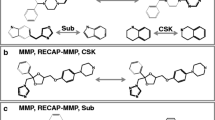Abstract
Computational scaffold hopping aims to identify core structure replacements in active compounds. To evaluate scaffold hopping potential from a principal point of view, regardless of the computational methods that are applied, a global analysis of conventional scaffolds in analog series from compound activity classes was carried out. The majority of analog series was found to contain multiple scaffolds, thus enabling the detection of intra-series scaffold hops among closely related compounds. More than 1000 activity classes were found to contain increasing proportions of multi-scaffold analog series. Thus, using such activity classes for scaffold hopping analysis is likely to overestimate the scaffold hopping (core structure replacement) potential of computational methods, due to an abundance of artificial scaffold hops that are possible within analog series.




Similar content being viewed by others
References
Hu Y, Stumpfe D, Bajorath J (2016) Computational exploration of molecular scaffolds in medicinal chemistry. J Med Chem 59:4062–4076
Müller G (2003) Medicinal chemistry of target family-directed masterkeys. Drug Discov Today 8:681–691
Hu Y, Stumpfe D, Bajorath J (2011) Lessons learned from molecular scaffold analysis. J Chem Inf Model 51:1743–1752
Schneider G, Neidhart W, Giller T, Schmid G (1999) “Scaffold-hopping” by topological pharmacophore search: a contribution to virtual screening. Angew Chem Int Ed 19:2894–2896
Schuffenhauer A (2012) Computational methods for scaffold hopping. Wires Comput Mol Sci 2:842–867
Hu Y, Stumpfe D, Bajorath J (2017) Recent advances in scaffold hopping. J Med Chem 60:1238–1246
Bemis GW, Murcko MA (1996) The properties of known drugs. 1. Molecular frameworks. J Med Chem 39:2887–2893
Dimova D, Stumpfe D, Hu Y, Bajorath J (2016) Analog series-based scaffolds: computational design and exploration of a new type of molecular scaffolds for medicinal chemistry. Future Sci OA 2:FSO149
Hu Y, Bajorath J (2010) Global assessment of scaffold hopping potential for current pharmaceutical targets. Med Chem Commun 1:339–344
Hu Y, Bajorath J (2015) Quantifying the tendency of therapeutic target proteins to bind promiscuous or selective compounds. PLoS ONE 10:e0126838
Stumpfe D, Dimova D, Bajorath J (2016) Computational method for the systematic identification of analog series and key compounds representing series and their biological activity profiles. J Med Chem 59:7667–7676
Kenny PW, Sadowski J (2004) Structure modification in chemical databases. In: Oprea TI (ed) Chemoinformatics in drug discovery. Wiley, Weinheim, p 271–285
Griffen E, Leach AG, Robb GR, Warner DJ (2011) Matched molecular pairs as a medicinal chemistry tool. J Med Chem 54:7739–7750
Gaulton A, Bellis LJ, Bento AP, Chambers J, Davies M, Hersey A, Light Y, McGlinchey S, Michalovich D, Al-Lazikani B, Overington JP (2012) ChEMBL: a large-scale bioactivity database for drug discovery. Nucleic Acids Res 40(Database issue):D1100–D1107
OEChem, version 1.7.7 (2012) OpenEye Scientific Software, Inc., Santa Fe, NM, USA
Acknowledgements
We thank OpenEye Scientific Software, Inc., for the free academic license of the OpenEye Toolkits.
Author information
Authors and Affiliations
Corresponding author
Rights and permissions
About this article
Cite this article
Dimova, D., Bajorath, J. Is scaffold hopping a reliable indicator for the ability of computational methods to identify structurally diverse active compounds?. J Comput Aided Mol Des 31, 603–608 (2017). https://doi.org/10.1007/s10822-017-0032-7
Received:
Accepted:
Published:
Issue Date:
DOI: https://doi.org/10.1007/s10822-017-0032-7




